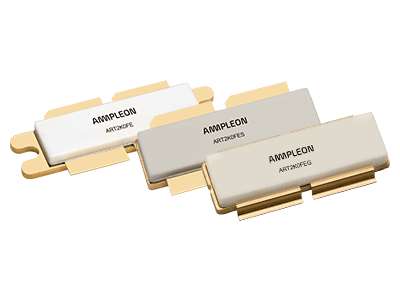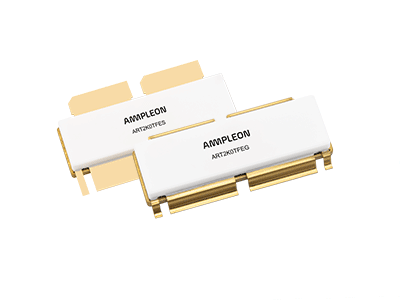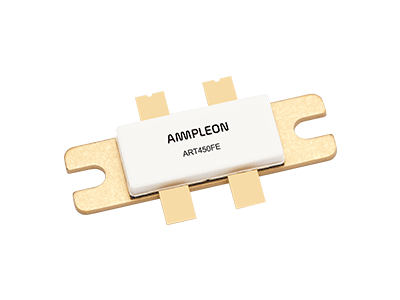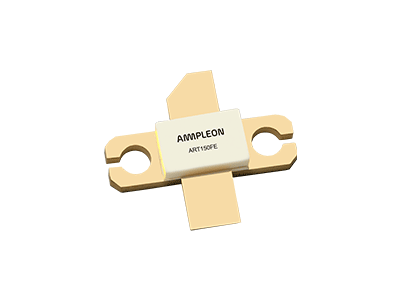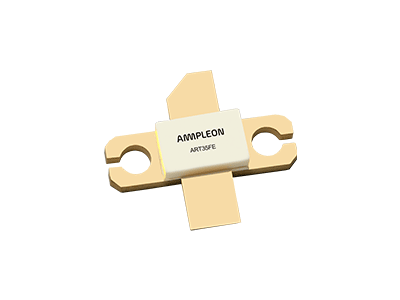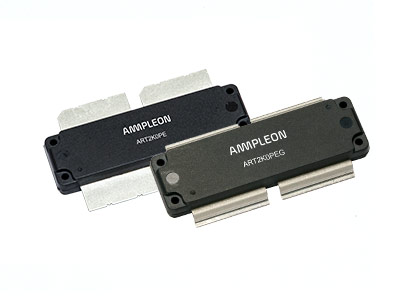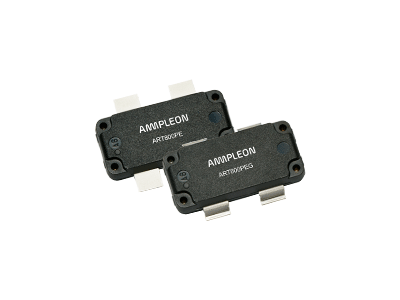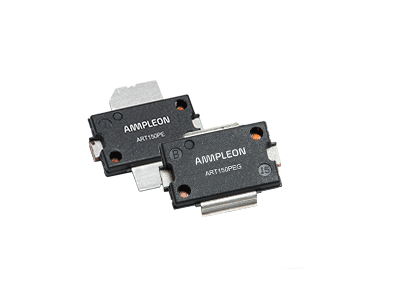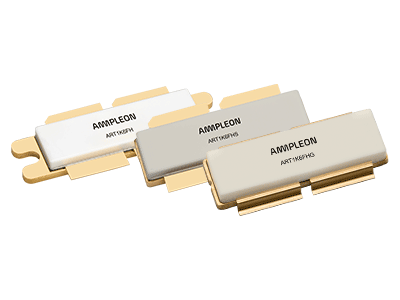(A)dvanced (R)ugged (T)echnology
We invite you to delve into the limitless possibilities of ART transistors. Their remarkable durability, precision, and efficiency have made them an indispensable force in shaping our modern world, from driving innovation in microchip manufacturing to fueling breakthroughs in sustainable energy solutions. The future is powered by Ampleon's ART transistors – be part of the transformation.
Ampleon's ART transistors are specifically engineered to deliver the best in terms of RF power, gain and efficiency, but more importantly, they boast crucial ruggedness and reliability features that set them apart from the competition. These vital features serve as a cornerstone of our product's capabilities. It is, without a doubt, one of the fundamental elements that make our product a standout choice for users seeking the highest level of performance and value under the harshest impedance mismatch and power cycling conditions.
It comes as no surprise that ART transistors have quietly emerged as the driving force behind modern technology and innovations. In today's landscape, they can be spotted across a wide range of applications, acting as RF sources in plasma generators, powering CO2 laser systems, contributing to fusion power reactors, and enabling the next generation of magnetic resonance imaging (MRI) scanners.
Here are a few instances demonstrating how ART transistors have woven themselves into the fabric of our daily lives, quietly but significantly impacting the way we live, work, and connect in our ever-evolving society.
Advanced microchips

ART power transistors play a crucial role in plasma generation and CO2 laser drivers for semiconductor
manufacturing, offering several key benefits. These transistors provide high-frequency amplification and
power capabilities, enabling efficient and precise control of plasma discharges and laser output. Their
ability to operate at radio frequencies allows for rapid switching, which is essential for generating
and maintaining stable plasma in semiconductor processing equipment. Additionally, ART transistors are
highly reliable, with excellent thermal performance, ensuring consistent and long-lasting operation in
demanding manufacturing environments. This reliability not only enhances process efficiency but also
reduces downtime and maintenance costs.
Overall, ART transistors are integral components in semiconductor manufacturing, facilitating the
production of high-quality microelectronics through their contributions to plasma generation and CO2
laser drivers. This will help address global challenges and transform the way we work, live, and
interact with the world around us.
Photovoltaic

ART transistors, employed in microwave annealing processes, hold a dual significance in both the
manufacturing and recycling of solar panels. In the manufacturing phase, these transistors are
instrumental in optimizing the performance of solar cells by precisely controlling the annealing
process. This ensures that the semiconductor materials used in the panels are tailored for maximum
efficiency, ultimately contributing to the production of high-quality and durable solar panels.
However, the importance of RF power transistors does not end there. In the recycling of solar panels,
these transistors play a crucial role in the recovery and rejuvenation of valuable materials. By using
microwave annealing techniques powered by ART transistors, it becomes possible to reclaim and reuse
semiconductor materials from old or damaged solar panels, reducing waste and environmental impact. This
closed-loop approach not only conserves resources but also aligns with the principles of sustainability
and circular economy, ensuring that the lifecycle of solar panels is extended, and their environmental
footprint minimized.
As the world embraces renewable energy solutions, the importance of ART transistors in this context
cannot be overstated. They bridge the gap between efficient solar panel manufacturing and responsible
end-of-life practices, forging a path towards a more sustainable and environmentally responsible future.
Fusion energy

ART transistors are pivotal components in the development and operation of fusion energy reactors,
exemplifying their critical importance in the quest for clean and sustainable energy sources. They are
responsible for delivering and controlling the RF energy essential for heating and stabilizing the
superheated plasma within a fusion reactor.
By precisely generating and controlling RF energy, these transistors contribute to achieving the
extremely high temperatures and pressures required for nuclear fusion, a clean and virtually limitless
source of energy. The reliability and efficiency of ART transistors are paramount because any
fluctuations or interruptions in the RF power delivery could disrupt the delicate balance of the fusion
reactor, impeding progress toward achieving sustainable fusion energy.
In essence, the ART transistors are catalysts for the advancement of fusion energy, holding the
potential to revolutionize our approach to clean, abundant, and environmentally friendly power
generation, addressing the pressing global need for sustainable energy solutions. By enabling the
maintenance of extreme plasma conditions, the ART transistors contribute to achieving the goal of
virtually limitless and emission-free energy.
Medical imaging

ART transistors hold a paramount role in the field of medical diagnostics, particularly in the operation
of MRI (Magnetic Resonance Imaging) systems. They are responsible for generating the crucial RF pulses
used to manipulate the magnetic resonance of hydrogen atoms within the patient's body, producing
detailed and high-resolution images of internal structures.
The precision, consistency, and reliability of ART transistors are critical in ensuring the accuracy of
MRI scans, as any fluctuations or interruptions in RF energy can compromise image quality and diagnostic
accuracy.
By enabling the creation of clear and informative medical images, ART transistors contribute to early
disease detection, accurate diagnoses, and treatment planning. This, in turn, empowers healthcare
professionals to provide timely and effective care to patients, making ART transistors indispensable
tools in the realm of modern medical imaging and diagnosis.
Selection of available application boards
Customized application boards are created upon request, tailored to the specific needs of each customer on a case-by-case basis.
|
Frequency (MHz) |
Product |
Application report |
Pout (W) |
Efficiency (%) |
Gain (dB) |
|
2 |
1300 |
80 |
20 |
||
|
13 |
AR211135* |
1005 |
90 |
29.6 |
|
|
1600 |
76.5 |
29.6 |
|||
|
27 |
1160 |
90.7 |
29.1 |
||
|
725 |
75 |
21 |
|||
|
41 |
1600 |
78.5 |
28 |
||
|
900 |
89 |
26 |
|||
|
172 |
85.1 |
30 |
|||
|
60 / 64 |
AR201093* |
1788 |
84.7 |
28 |
|
|
81 |
1393 |
81.3 |
19.7 |
||
|
88 - 108 |
1490 |
82.6 ~ 84.7 |
24.2 |
||
|
128 |
AR221142* |
2380 |
78 |
26.6 |
|
|
352 |
AR201023* |
1500 |
74 |
20 |
* For access, please contact our local sales representative via: www.ampleon.com/contact
Competitive benchmarking
|
Product |
BLF188 |
BLF189 |
ART1K9 |
ART2K0 |
ART2K5 |
1K25 |
1K5 |
1K80 |
MQ012K0VPX |
RF5L02K0CF4 |
HTH8G02P1K4H |
|
Technology |
LDMOS |
||||||||||
|
Package |
ACC* |
ACC and OMP** |
ACC and OMP |
ACC |
ACC |
ACC |
|||||
|
Vds (V) |
50 |
50 / 55 |
65 |
75 |
50 |
65 |
50 |
55 |
50 / 55 |
||
|
Min. BVdss (V) |
135 |
177 |
203 |
203 |
133 |
135 |
179 |
140 typ. |
110 |
135 typ. |
|
|
Output Power P1dB (W) |
1400 |
1700 |
1700 / 1900 |
2000 |
2500 |
1250 |
1500 |
1800 |
2000 |
2000 |
~1200 / ~1400*** |
|
VSWR |
65:1 |
65:1 |
65:1 |
n.a. |
10:1 |
65:1 |
|||||
* ACC: Air Cavity Ceramic
** OMP: Over-molded Plastic
*** Converted from the output power figures at Psat as given in the product data sheet
Featured products
Committed to your success
During the entire process from design to delivery, we provide a range of support options to address your needs. Whether you require load-pull data, application boards, samples, ADS / AWR models, assistance with a complex design challenge or seek quick advice, we are on stand-by to support you. Our application engineering resources are spread around the globe, with our offices in Nijmegen / The Netherlands, Toulouse / France, Smithfield / USA, and Shanghai / China.



